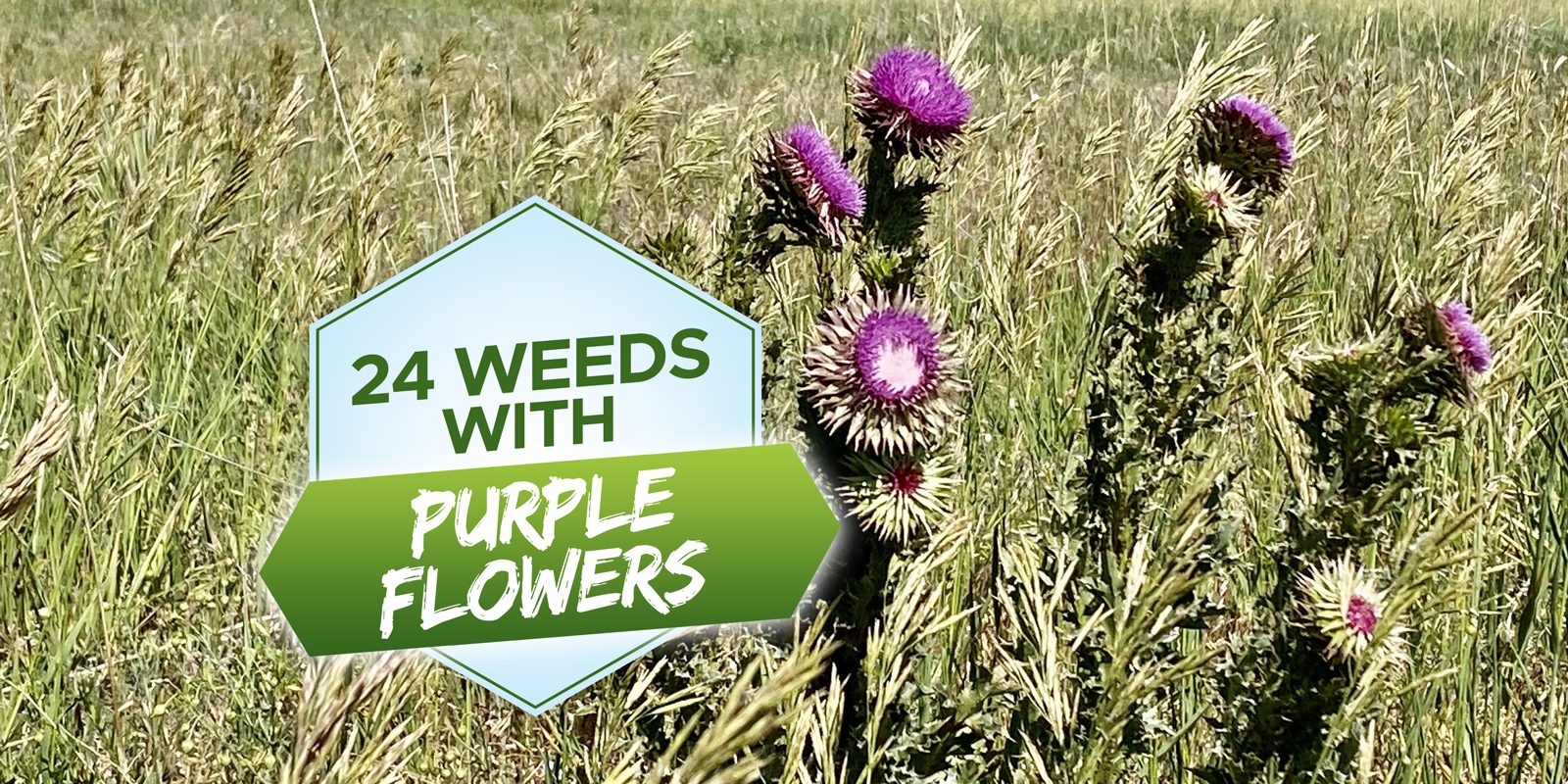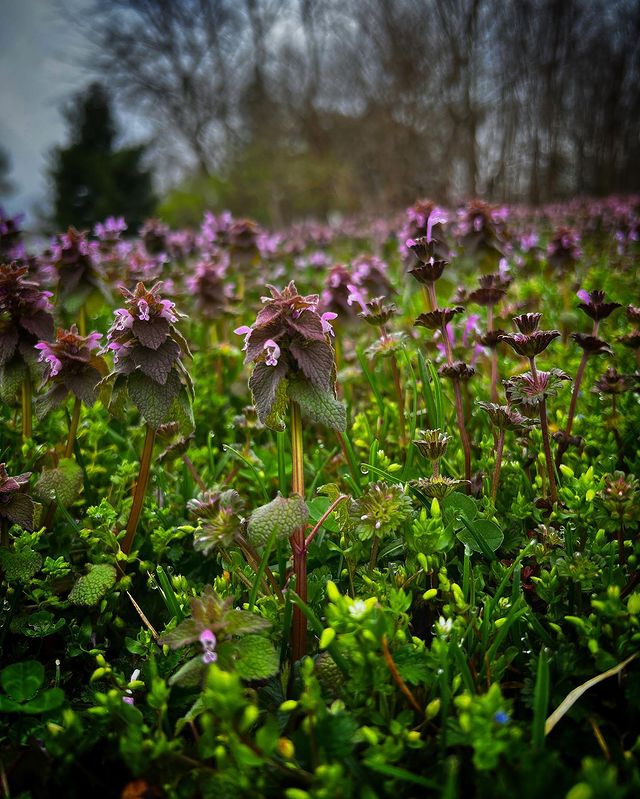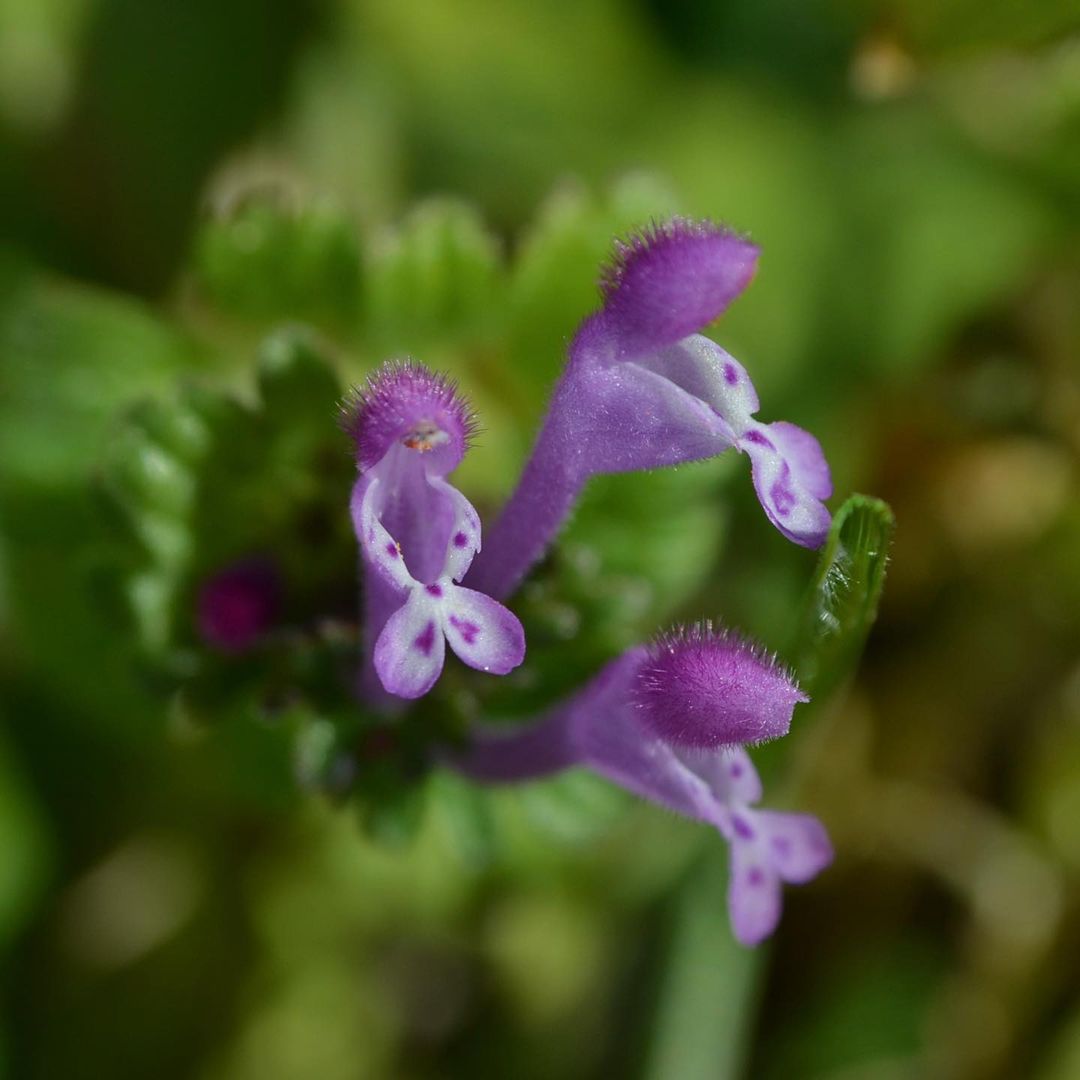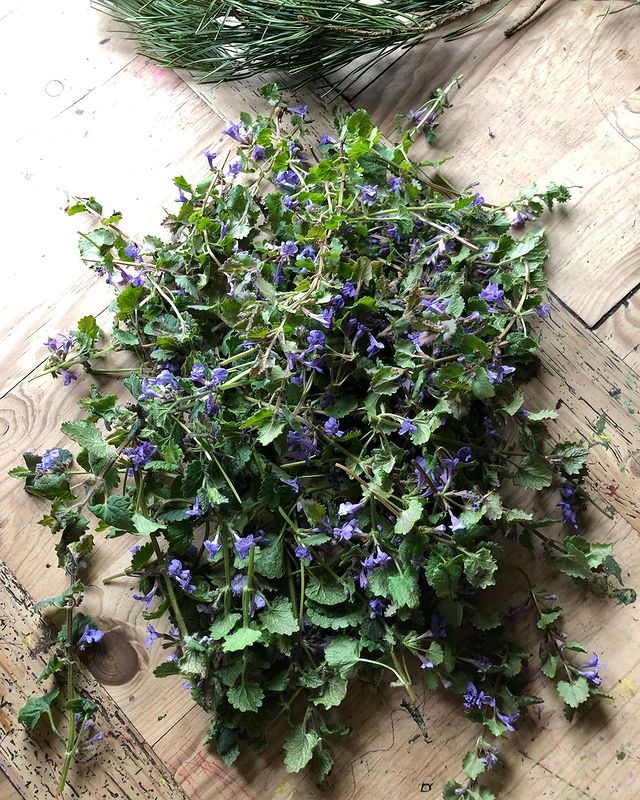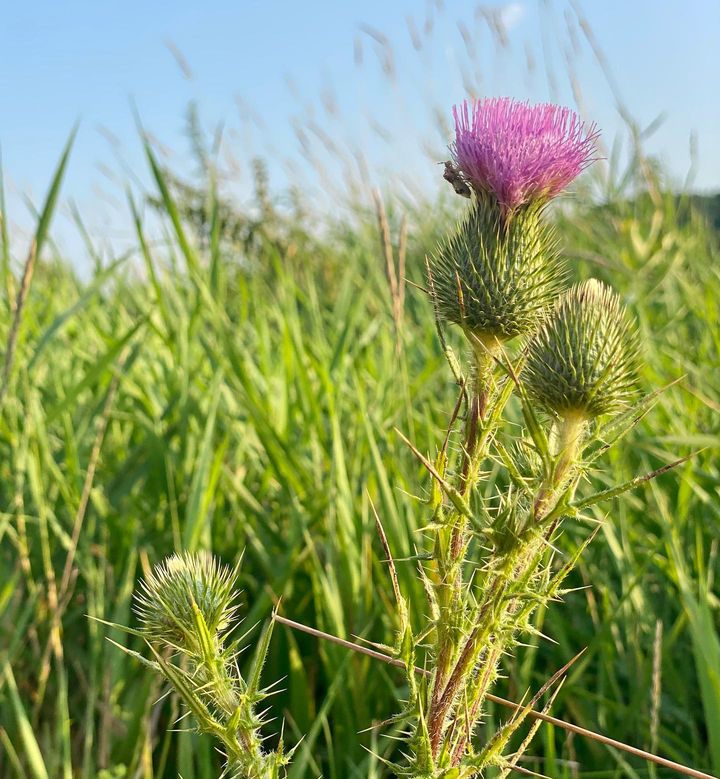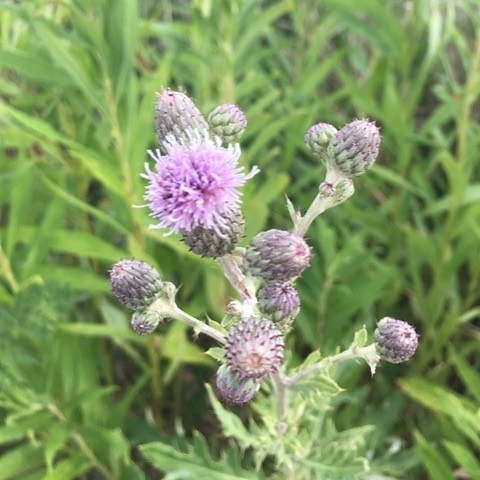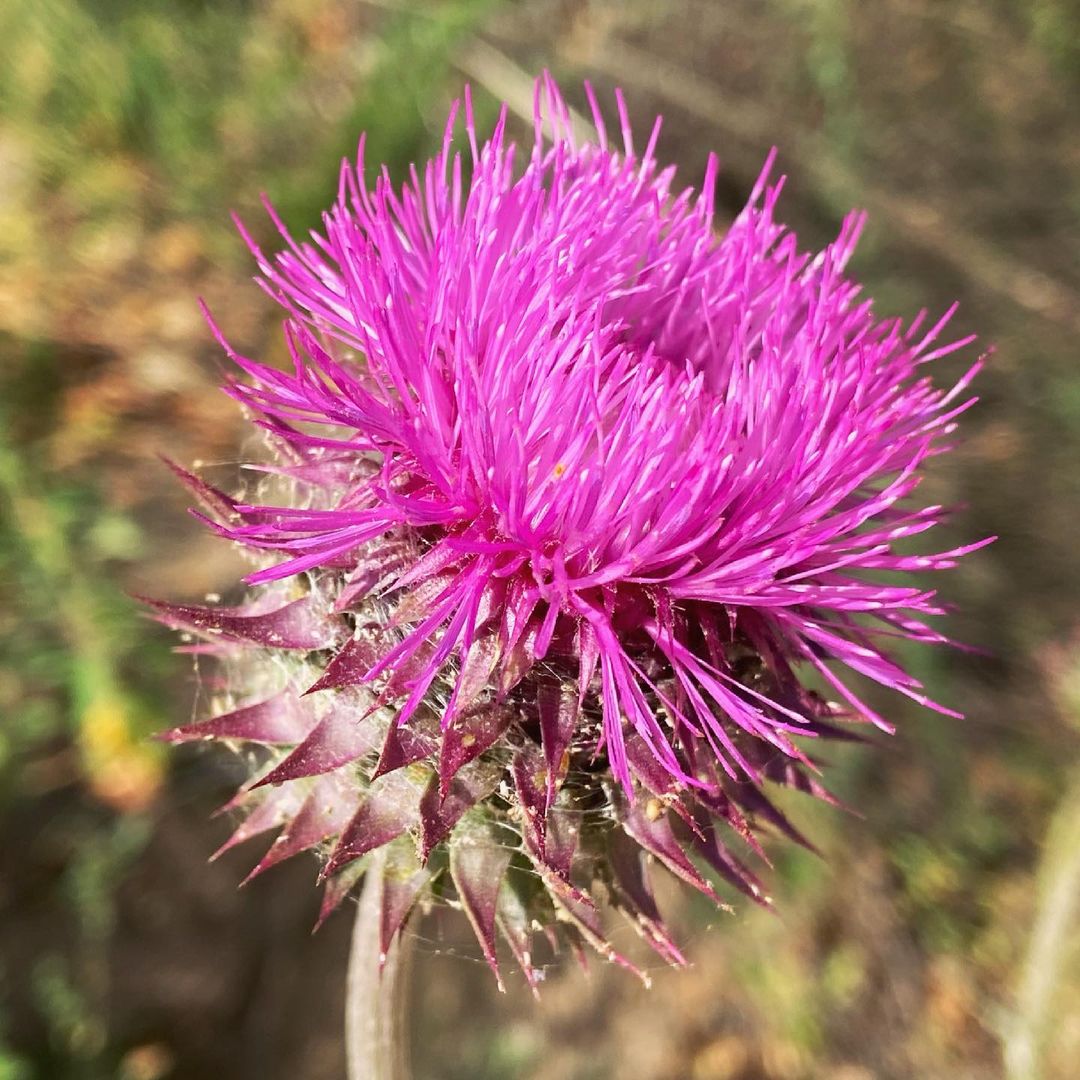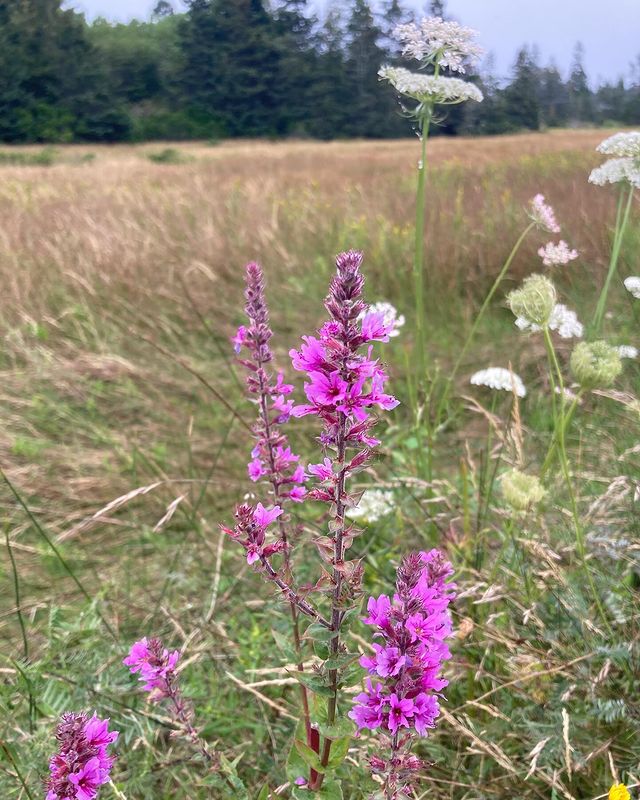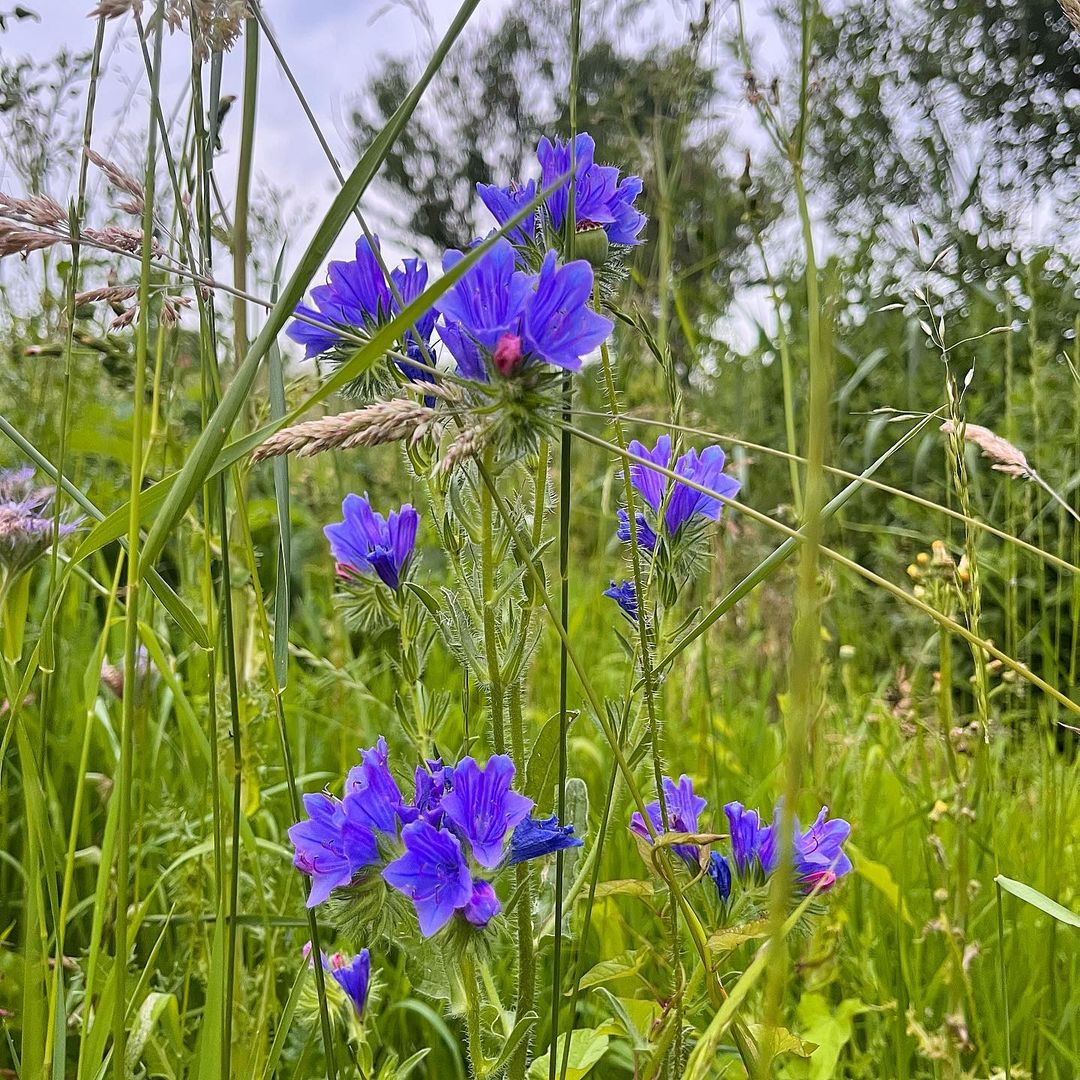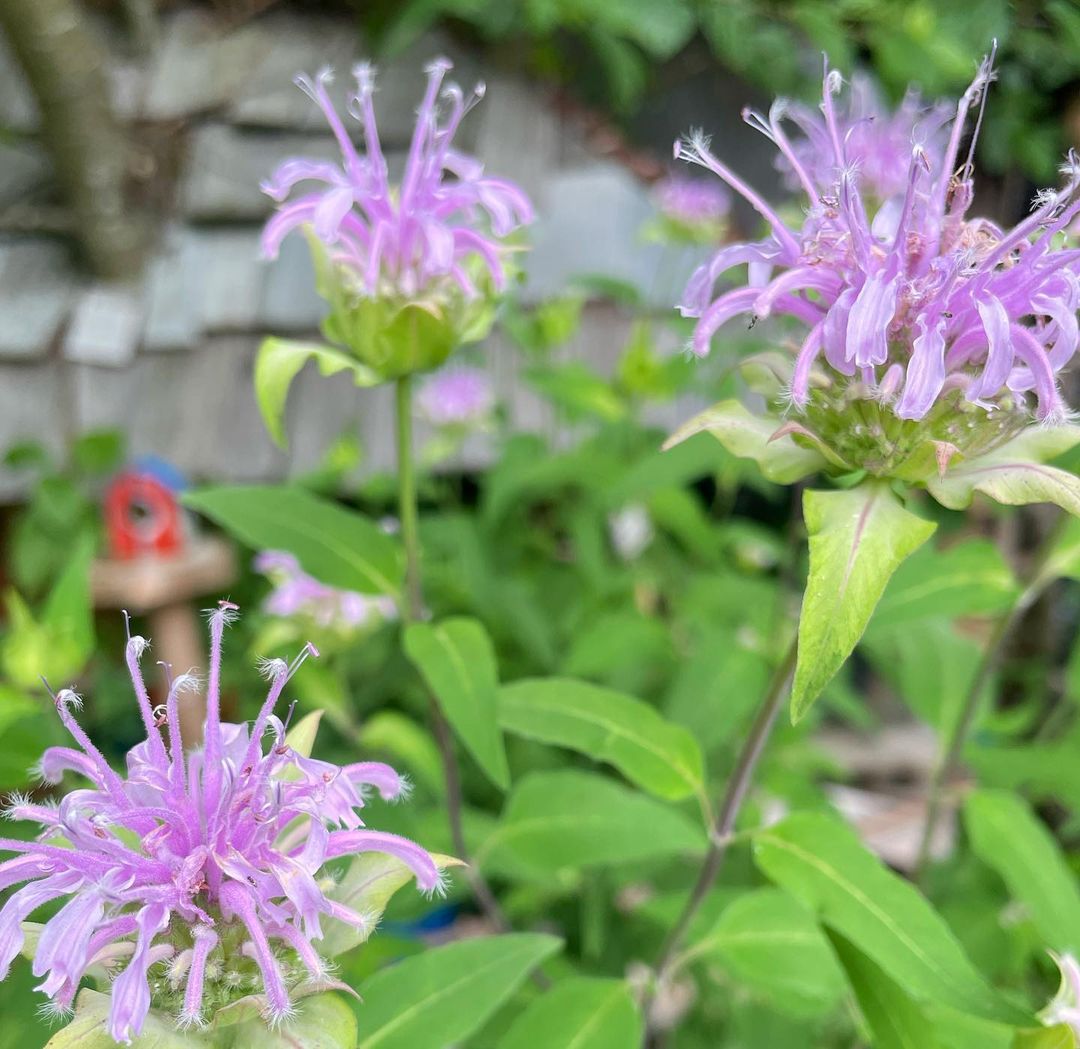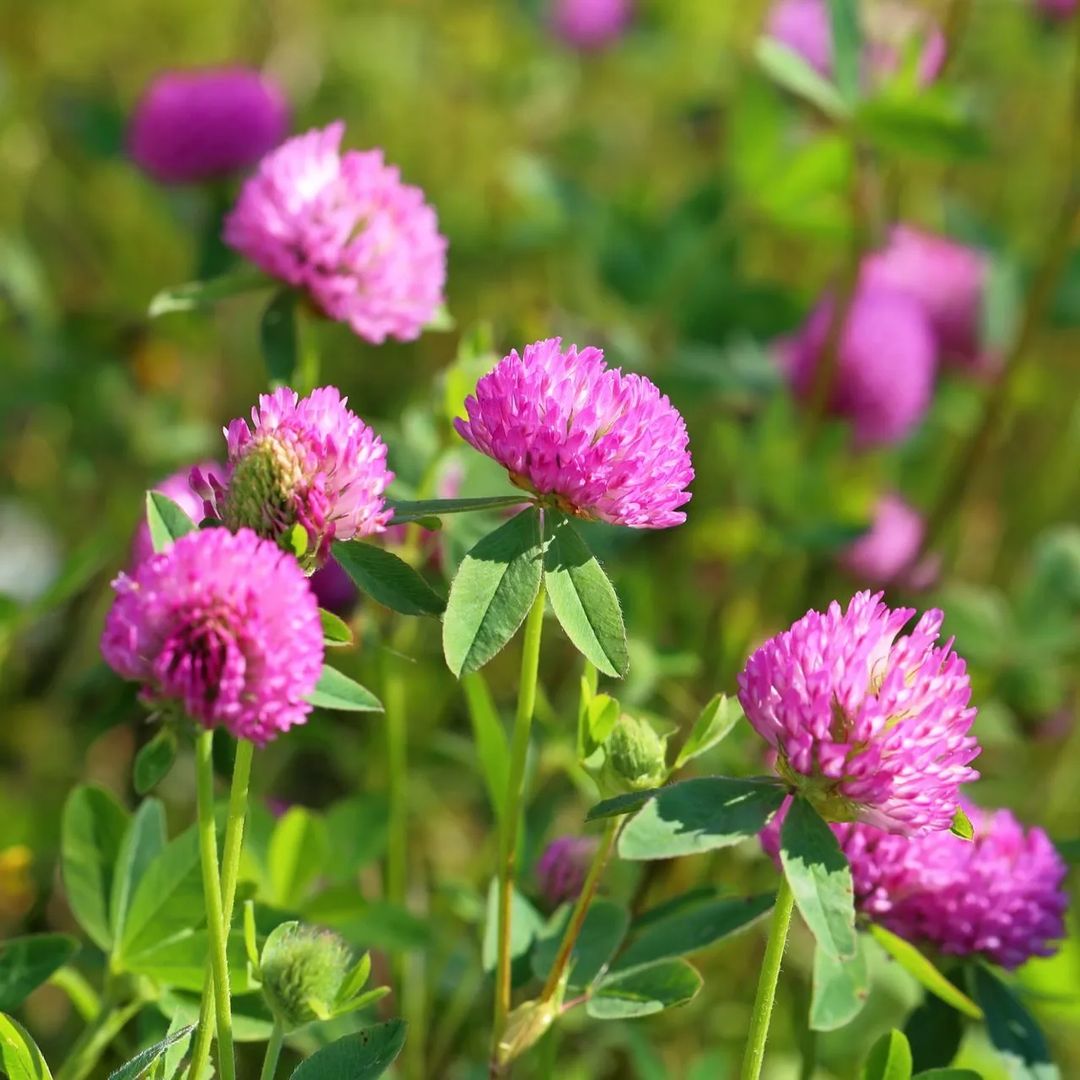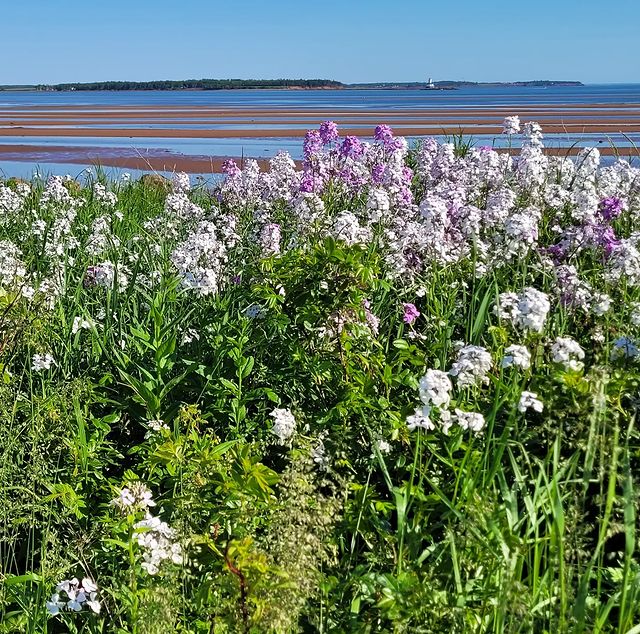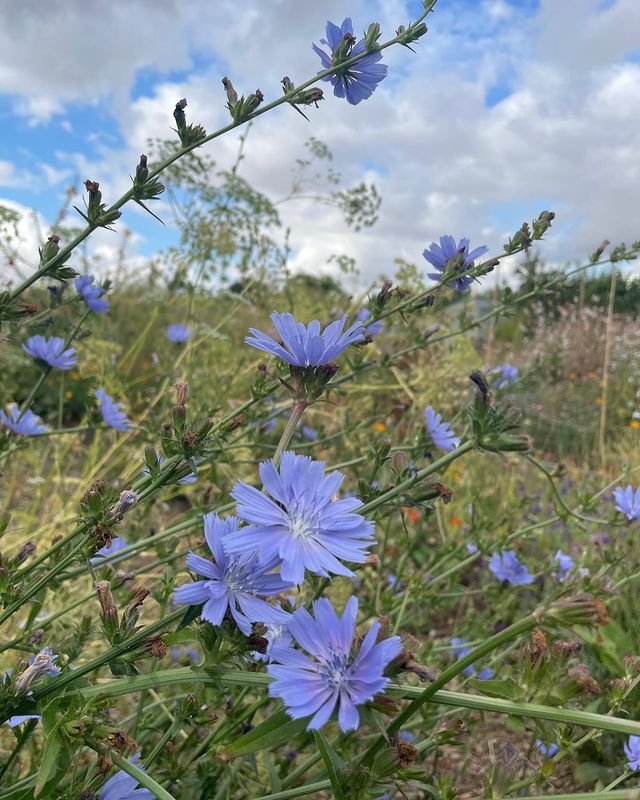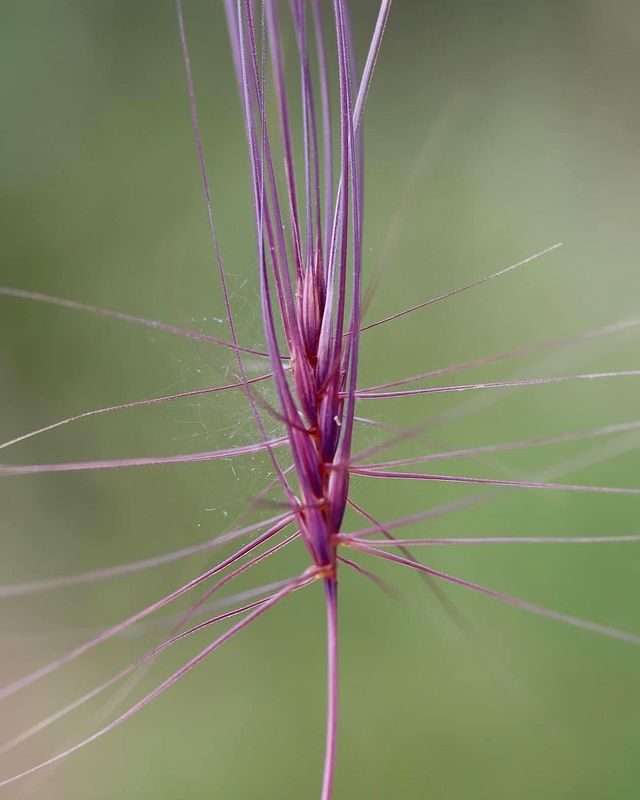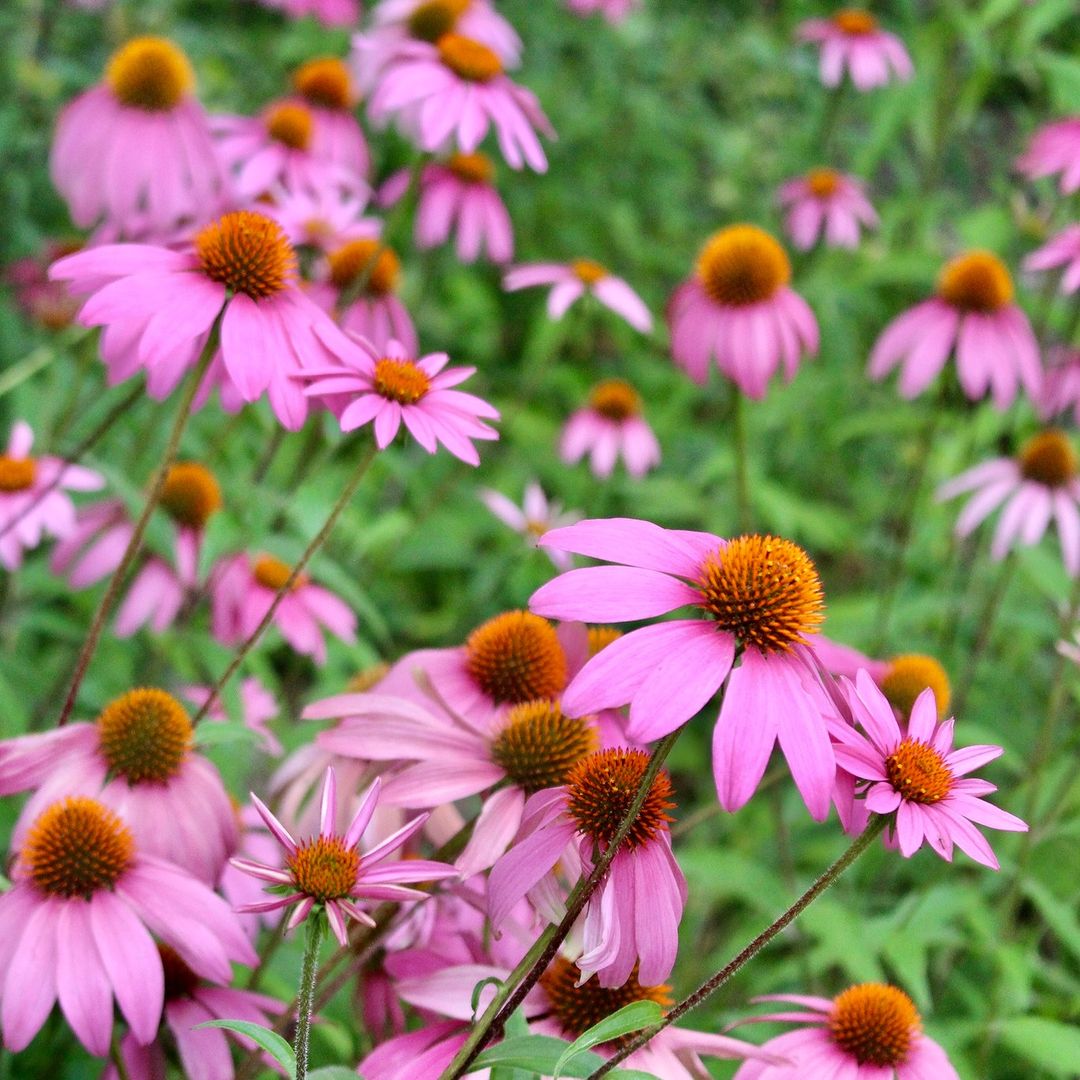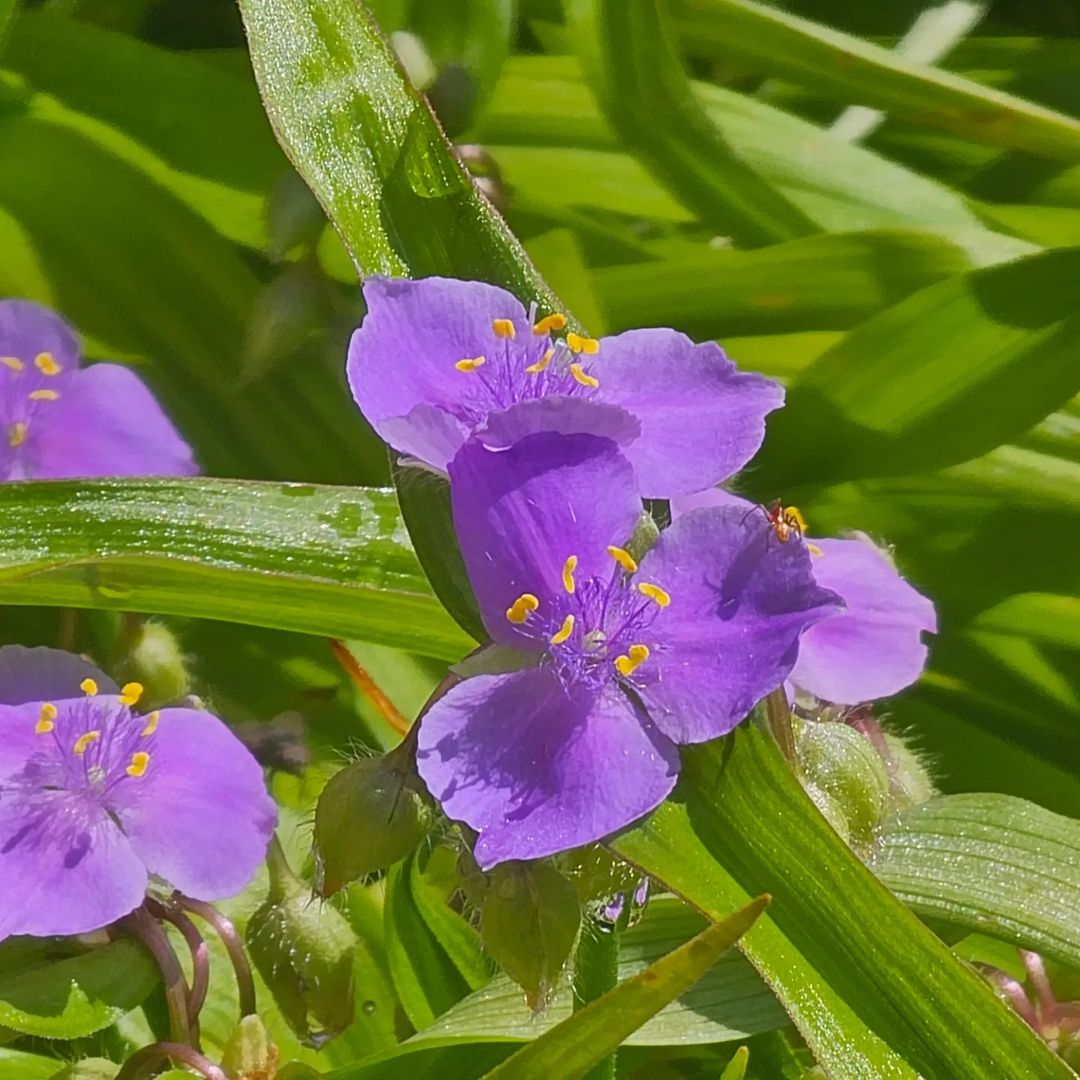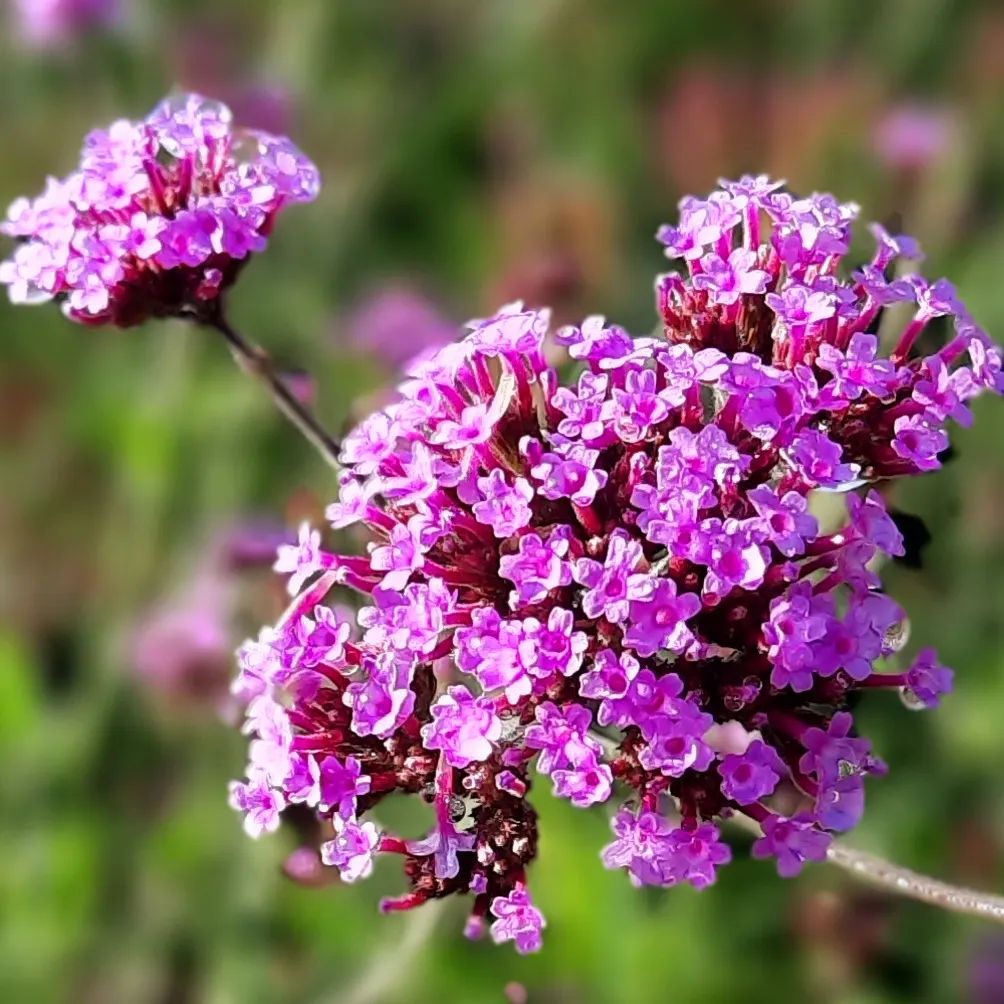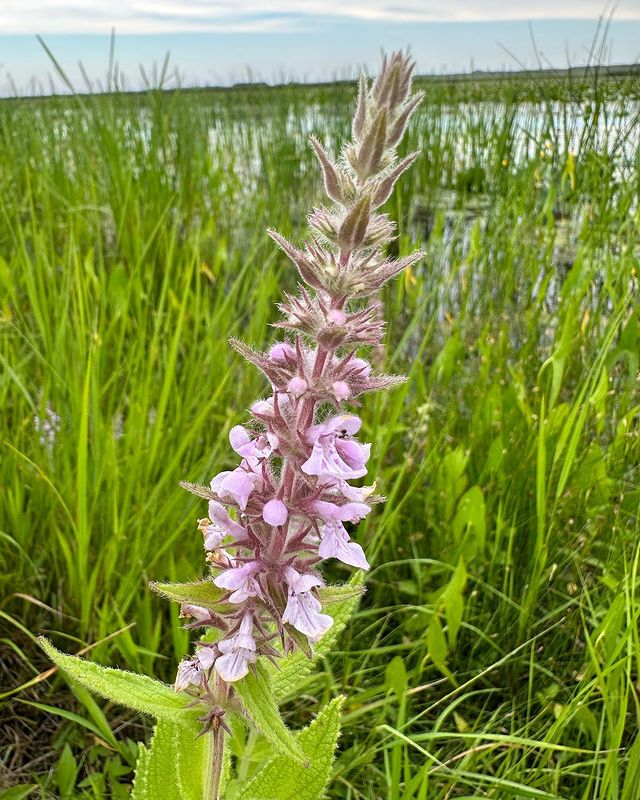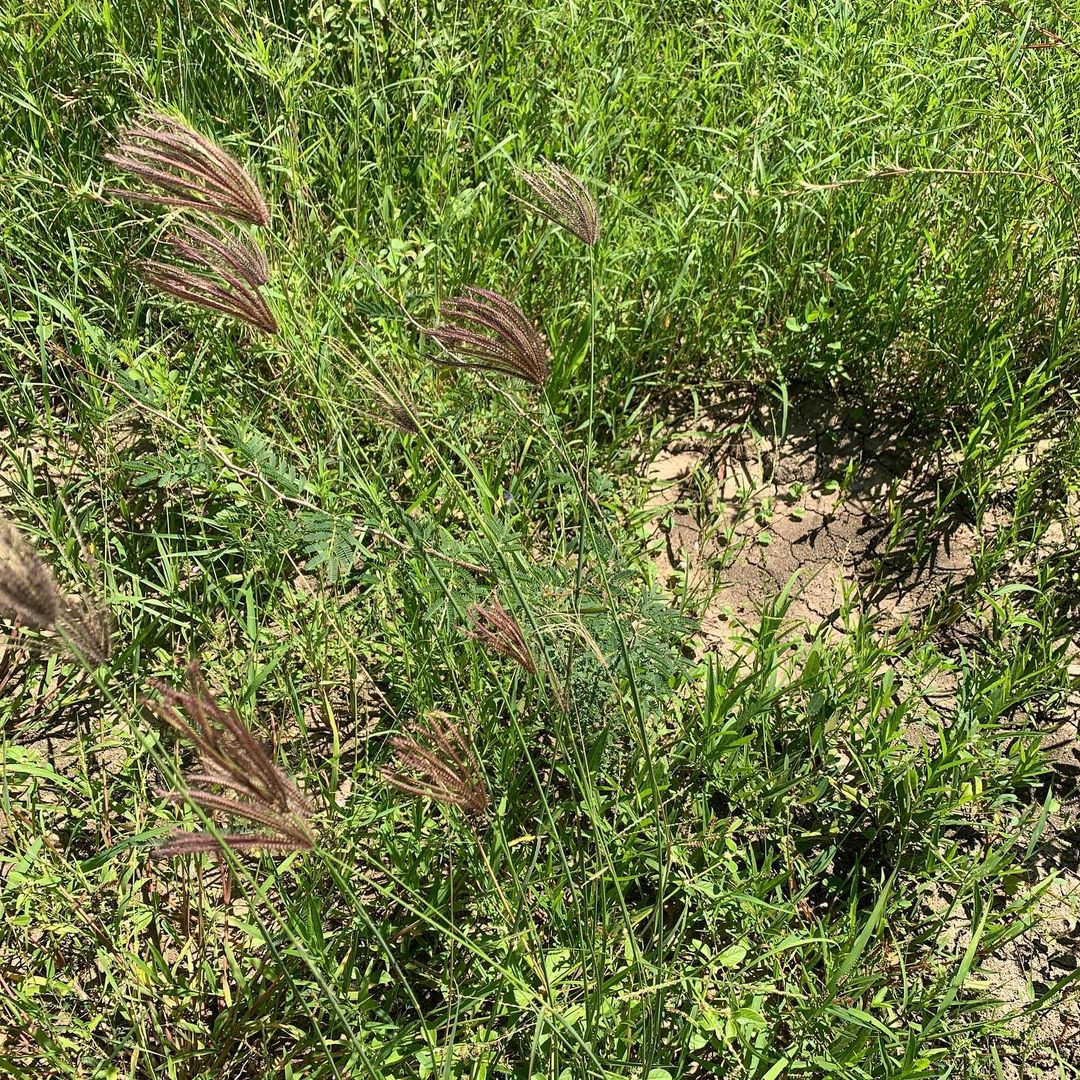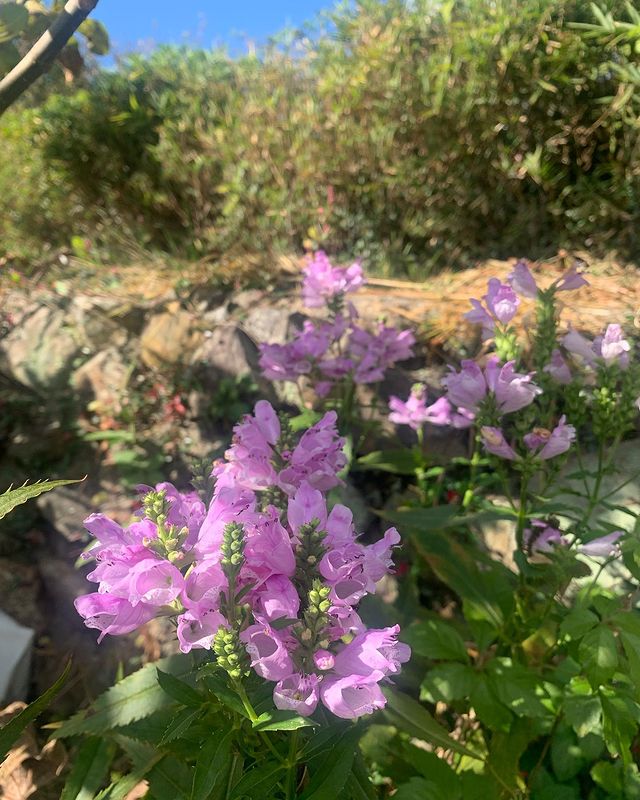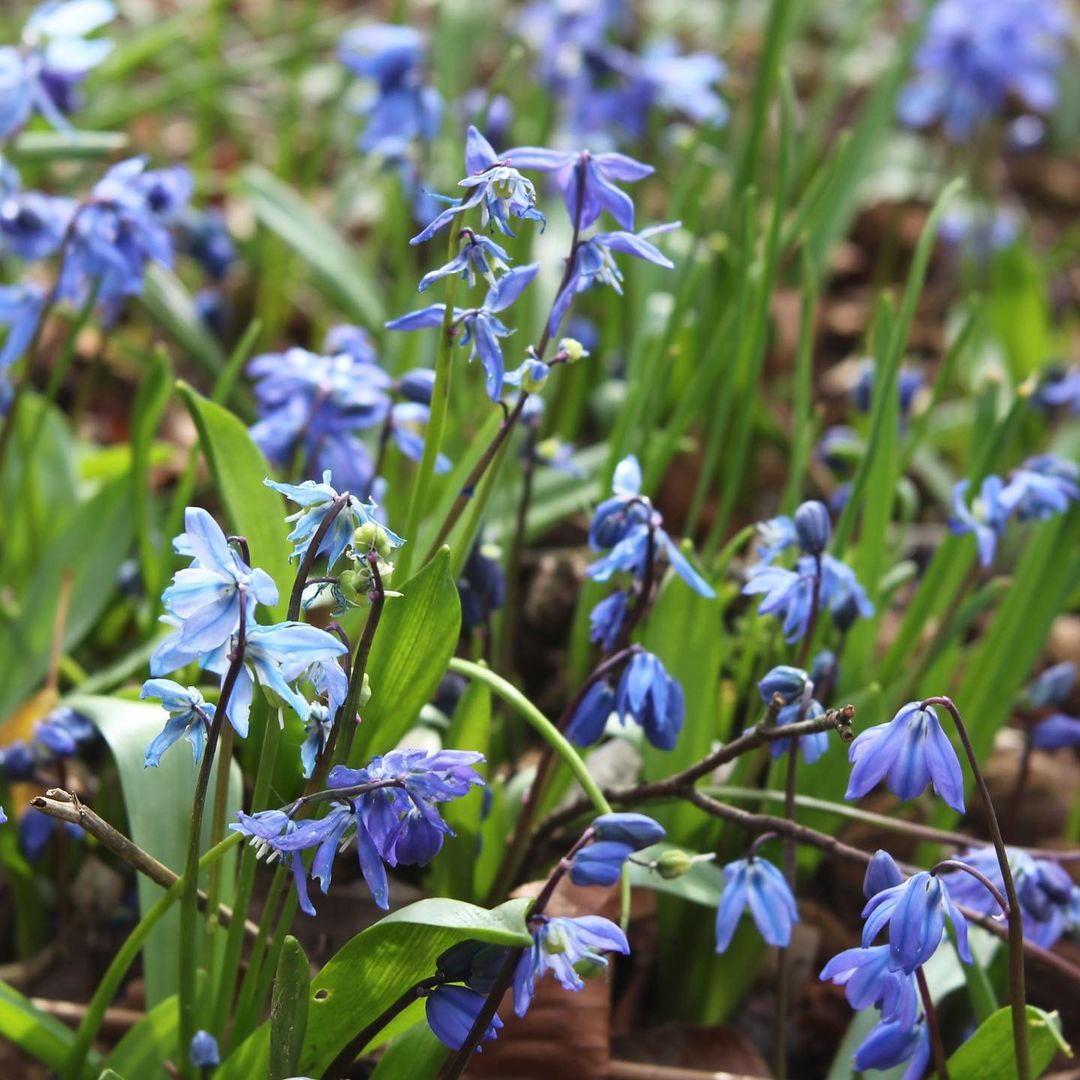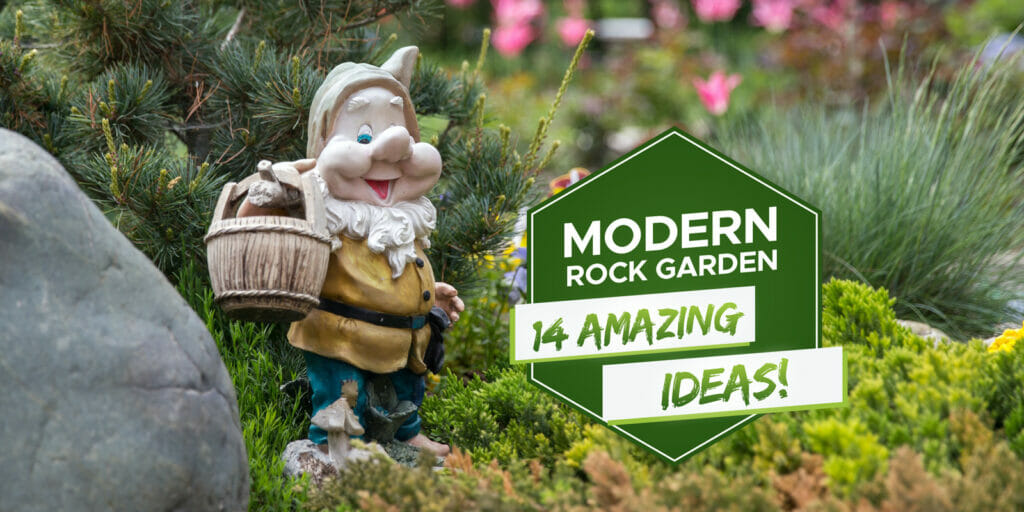We all love a beautiful garden, but sometimes, it can be challenging to keep it free of weeds!
Weeds are unwanted plants that can take over your garden, making it look unkempt and uninviting. However, not all weeds are created equal, and some can be quite beautiful, as you’ll see below!
Some weeds have stunning purple flowers that can add a huge amount of color to your garden.
We’re going to introduce you to 24 weeds with purple flowers that you may already have in your garden.
So, whether you are a seasoned gardener or a beginner, this article will help you identify and appreciate the beauty of any weeds with purple flowers in your yard!
Identifying Characteristics of Purple Flowering Weeds
When it comes to identifying purple flowering weeds, there are a few key characteristics to look out for.
The leaves of purple flowering weeds can come in a variety of shapes and textures. Some may have smooth and glossy leaves, while others may have rough and hairy leaves. The shape of the leaves can also vary, from long and narrow to round and broad.
It’s important to note that not all purple flowering weeds will have the same leaf shape and texture, so it’s important to look at other identifying characteristics as well.
Stem and Root Systems
The stem and root systems of purple flowering weeds can also vary. Some may have thick and sturdy stems, while others may have thin and delicate stems.
The root systems of these weeds can also differ, with some having shallow roots and others having deep taproots.
When identifying these weeds, it’s important to consider the stem and root systems, as they can provide valuable information about the plant’s growth habits and potential impact on surrounding plants.
Flower Petal Arrangement
One of the most distinguishing characteristics of purple flowering weeds is their flower petal arrangement. Some may have single flowers, while others may have clusters of flowers. The shape and size of the flowers can also vary, from small and delicate to large and showy.
It’s important to pay attention to the flower petal arrangement when identifying these weeds, as it can help to narrow down the possible species.
Overall, identifying purple flowering weeds requires a careful examination of their various characteristics.
By paying attention to the leaf shape and texture, stem and root systems, and flower petal arrangement, we can better understand these weeds and take steps to control their growth in our gardens.
24 Weeds With Purple Flowers
Distinguishing flowering weeds can be a challenging task. Some of these weeds resemble other plants, including those you may want to keep in your garden or local environment.
The following list aims to assist you in identifying purple weeds in your lawn and garden and provides guidance on safely and efficiently managing them.
Purple Deadnettle (Lamium purpureum)
Purple deadnettle, scientifically known as Lamium purpureum, is a prevalent weed often found in gardens and lawns across the United States. It’s characterized by its square stems and distinctive heart-shaped leaves that exhibit a purplish tint. While it may be considered a weed, it’s worth noting that Purple Deadnettle offers both challenges and benefits to gardeners and landscapers.
Key Details:
- Binomial Name: Lamium purpureum
- Life Cycle: Annual
- Bloom Time: March to December
- Hardiness Level: Purple Deadnettle is hardy and adaptable, able to grow in various soil types and conditions.
- Toxicity: Purple Deadnettle is non-toxic to humans and animals and is sometimes used in herbal medicine.
Characteristics:
- Leaves: The heart-shaped leaves of Purple Deadnettle are distinct with a purplish tint, making them easy to identify.
- Flowers: The small, vibrant purple flowers of this weed are one of its most notable features. They begin to bloom in early spring and continue throughout the year, even in milder climates.
Henbit (Lamium amplexicaule)
Henbit, scientifically known as Lamium amplexicaule, is a member of the Lamium family and shares similarities with Purple Deadnettle. Like its close relative, Henbit is characterized by its distinctive purple flowers and leaves, but it stands taller and has more erect stems. Understanding the characteristics and growth habits of Henbit is crucial for effective weed management.
Key Details:
- Binomial Name: Lamium amplexicaule
- Life Cycle: Annual
- Bloom Time: Henbit typically blooms from late winter to early spring.
- Hardiness Level: Henbit is adaptable and can thrive in various soil types and conditions.
- Toxicity: Henbit is non-toxic to humans and animals and is not known to be harmful if accidentally ingested.
Characteristics:
- Leaves: Henbit’s leaves are similar to those of Purple Deadnettle, featuring a purplish tint and a distinctive shape.
- Flowers: The flowers of Henbit are small, tubular, and purple, making them easily recognizable in lawns and gardens.
Creeping Charlie (Glechoma hederacea)
Creeping Charlie, scientifically known as Glechoma hederacea, is a low-growing weed with distinct purple flowers that typically bloom in early spring. Recognizable by its round leaves with scalloped edges and a pleasant minty aroma, Creeping Charlie can be both a nuisance and a challenge to control in gardens and lawns due to its unique growth characteristics.
Key Details:
- Binomial Name: Glechoma hederacea
- Life Cycle: Perennial
- Bloom Time: Creeping Charlie typically blooms in early spring, producing small, tubular, purple flowers.
- Hardiness Level: This weed is adaptable and can thrive in a variety of soil types and environmental conditions.
- Toxicity: Creeping Charlie is not considered toxic to humans or animals.
Characteristics:
- Leaves: The leaves of Creeping Charlie are round, scalloped, and green with a distinct minty fragrance when crushed.
- Flowers: The small purple flowers are tubular in shape and grow in clusters, adding a splash of color to lawns and gardens in early spring.
Ground Ivy (Glechoma hederacea)
Ground Ivy, scientifically known as Glechoma hederacea, is a member of the mint family, similar to Creeping Charlie. This weed is characterized by its small purple flowers and round leaves that bear a resemblance to those of Creeping Charlie. Ground Ivy is known for its invasive nature and can pose challenges, particularly in shaded areas.
Key Details:
- Binomial Name: Glechoma hederacea
- Life Cycle: Ground Ivy is a perennial weed.
- Bloom Time: It typically produces small, tubular, purple flowers in the spring.
- Hardiness Level: Ground Ivy can thrive in a variety of soil types and is known for its adaptability.
- Toxicity: Ground Ivy is generally not considered toxic to humans or animals.
Characteristics:
- Leaves: Ground Ivy’s leaves are round with scalloped edges, similar in appearance to Creeping Charlie, and may have a slight minty aroma when crushed.
- Flowers: The small, purple flowers of Ground Ivy grow in clusters and are a common sight in lawns and gardens during the spring.
Bull Thistle (Cirsium vulgare)
Bull thistle, scientifically known as Cirsium vulgare, is a biennial weed characterized by its large, striking purple flowers that typically bloom in late summer. This weed has spiny leaves and stems, and it can reach heights of up to six feet. Bull thistle is of particular concern in some regions due to its classification as a noxious weed, primarily because of its potential harm to livestock.
Key Details:
- Binomial Name: Cirsium vulgare
- Life Cycle: Bull thistle is a biennial, meaning it has a two-year life cycle.
- Bloom Time: The plant produces its prominent purple flowers in late summer, providing a late-season source of nectar for pollinators.
- Hardiness Level: Bull thistle is known for its adaptability and can grow in various soil types and conditions.
- Toxicity: While the spiny nature of Bull Thistle can be a physical irritant to animals, it is not typically considered highly toxic. However, it can negatively impact livestock due to its spines.
Characteristics:
- Leaves: The leaves of Bull Thistle are deeply lobed and covered in sharp spines, making it an unappealing food source for most herbivores.
- Flowers: The large purple flowers are a distinguishing feature of Bull Thistle and attract pollinators such as bees and butterflies.
DON’T MISS: Vine plants with purple flowers.
Canada Thistle (Cirsium arvense)
Canada thistle, scientifically known as Cirsium arvense, is another thistle weed known for its purple flowers. This weed is particularly notorious for its deep root system, which makes it a challenging and persistent weed to control. Understanding its characteristics and growth habits is crucial for effective management.
Key Details:
- Binomial Name: Cirsium arvense
- Life Cycle: Canada Thistle is a perennial weed, meaning it can live for multiple years.
- Bloom Time: It produces small, purple flowers during the summer months.
- Root System: Canada Thistle is known for its extensive and deep root system, which can make eradication difficult.
- Hardiness Level: It is adaptable and can thrive in various soil types and conditions.
Characteristics:
- Leaves: The leaves of Canada Thistle are deeply lobed with spiny edges, a characteristic common to many thistle species.
- Flowers: Its purple flowers, while relatively small, are numerous and can create a noticeable display in gardens and fields during the summer.
Musk Thistle (Carduus nutans)
Musk thistle, scientifically known as Carduus nutans, is a biennial weed recognized for its impressive large purple flowers that typically bloom in early summer. This weed features spiny leaves and stems and can reach heights of up to six feet. In certain regions, Musk thistle is classified as a noxious weed due to its potential harm to livestock.
Key Details:
- Binomial Name: Carduus nutans
- Life Cycle: Musk thistle is a biennial weed, meaning it completes its life cycle over two years.
- Bloom Time: The plant produces its prominent purple flowers in early summer, providing a seasonal source of nectar for pollinators.
- Hardiness Level: Musk thistle is known for its adaptability and can grow in various soil types and conditions.
- Toxicity: While the spiny nature of Musk Thistle can be a physical irritant to animals, it is not typically considered highly toxic. However, it can negatively impact livestock due to its spines.
Characteristics:
- Leaves: Musk Thistle’s leaves are deeply lobed and covered in sharp spines, making it an unappealing food source for most herbivores.
- Flowers: The large, showy purple flowers are a distinguishing feature of Musk Thistle and attract pollinators such as bees and butterflies.
Purple Loosestrife (Lythrum salicaria)
Purple loosestrife, scientifically known as Lythrum salicaria, is a perennial weed known for its tall spikes of striking purple flowers that typically bloom in mid to late summer. This plant can reach heights of up to six feet and features lance-shaped leaves. It is widely considered an invasive species in many regions due to its capacity to rapidly dominate wetlands and other natural habitats.
Key Details:
- Binomial Name: Lythrum salicaria
- Life Cycle: Purple Loosestrife is a perennial weed, meaning it can persist for multiple years.
- Bloom Time: This weed produces its eye-catching purple flowers during mid to late summer.
- Hardiness Level: Purple Loosestrife is known for its adaptability and can thrive in various soil types, particularly wet or marshy areas.
- Invasive Status: It is widely regarded as an invasive species in many areas due to its aggressive spread and ability to displace native vegetation.
Characteristics:
- Leaves: The lance-shaped leaves of Purple Loosestrife are typically arranged in pairs along the stem and are green with a reddish or purplish tint.
- Flowers: The tall spikes of vibrant purple flowers are a distinctive feature and can create a visually striking display in wetland environments.
Viper’s Bugloss (Echium vulgare)
Viper’s bugloss, scientifically known as Echium vulgare, is a biennial weed known for its tall spikes of striking purple flowers that typically bloom in early summer. This plant features rough, hairy leaves and stems, and it can reach heights of up to three feet. In some regions, Viper’s bugloss is classified as an invasive species due to its rapid spread and its ability to outcompete native plants.
Key Details:
- Binomial Name: Echium vulgare
- Life Cycle: Viper’s Bugloss is a biennial weed, meaning it completes its life cycle over two years.
- Bloom Time: This weed produces its tall spikes of purple flowers in early summer, often attracting pollinators.
- Hardiness Level: Viper’s Bugloss is known for its adaptability and can grow in various soil types and environmental conditions.
- Invasive Status: It is considered an invasive species in some areas due to its competitive nature and potential harm to native flora.
Characteristics:
- Leaves: Viper’s Bugloss leaves are rough and covered in bristles, giving them a distinctive texture and appearance.
- Flowers: The tall spikes of vibrant purple flowers are a key identifying feature and are often visited by bees and other pollinators.
Wild Bergamot (Monarda fistulosa)
Wild bergamot, scientifically known as Monarda fistulosa, is a perennial plant known for its pinkish-purple flowers that typically bloom in mid to late summer. This plant features lance-shaped leaves and emits a pleasant minty aroma. Wild bergamot has a unique status as both a beloved garden plant and a potential invasive species in certain regions.
Key Details:
- Binomial Name: Monarda fistulosa
- Life Cycle: Wild Bergamot is a perennial plant, meaning it can persist for multiple years.
- Bloom Time: This plant produces its distinctive pinkish-purple flowers during mid to late summer.
- Characteristics: Wild Bergamot is characterized by its lance-shaped leaves and aromatic foliage, which is often used in herbal teas and attracts pollinators.
- Usage: It is a popular garden plant and is cultivated for its attractive flowers and aromatic leaves.
- Invasive Potential: In some areas, Wild Bergamot can be invasive, spreading rapidly and potentially displacing native vegetation.
Characteristics:
- Leaves: The leaves of Wild Bergamot are lance-shaped and emit a minty fragrance when crushed.
- Flowers: The pinkish-purple flowers are tubular in shape and are arranged in dense clusters, making them highly attractive to pollinators like bees and butterflies.
Red Clover (Trifolium pratense)
Red clover, scientifically known as Trifolium pratense, is a common plant known for its pinkish-purple flowers that typically bloom in early summer. This plant features three-parted leaves and a taproot. Red clover is versatile, serving as a valuable cover crop or forage crop, but it can also become a nuisance weed in gardens and lawns if not properly managed.
Key Details:
- Binomial Name: Trifolium pratense
- Life Cycle: Red Clover is typically a short-lived perennial or biennial plant, although it can also be an annual.
- Bloom Time: It produces its distinctive pinkish-purple flowers in early summer.
- Characteristics: Red Clover is known for its compound leaves, each consisting of three leaflets, and its globe-shaped flower heads.
- Usage: It is commonly used as a cover crop to improve soil fertility, as well as a forage crop for livestock.
- Nuisance Weed: In some contexts, Red Clover can become a nuisance weed, spreading in gardens and lawns.
Characteristics:
- Leaves: The leaves of Red Clover are trifoliate, with three leaflets per leaf, and have a distinctive “V” shape.
- Flowers: The pinkish-purple flowers form dense, rounded clusters and are attractive to pollinators.
Dame’s Rocket (Hesperis matronalis)
Dame’s rocket, scientifically known as Hesperis matronalis, is a biennial weed known for its fragrant purple flowers that typically bloom in mid to late spring. This plant features lance-shaped leaves and can grow up to three feet tall. Dame’s rocket has a dual status as both an ornamental garden plant and a potential invasive species in some areas.
Key Details:
- Binomial Name: Hesperis matronalis
- Life Cycle: Dame’s Rocket is a biennial plant, meaning it completes its life cycle over two years.
- Bloom Time: This plant produces its fragrant purple flowers in mid to late spring.
- Characteristics: Dame’s Rocket is characterized by its lance-shaped leaves and sweetly scented flowers.
- Usage: It is sometimes cultivated as an ornamental garden plant for its attractive blooms and fragrance.
- Invasive Potential: In certain regions, Dame’s Rocket is considered invasive, spreading quickly and potentially displacing native flora.
Characteristics:
- Leaves: The leaves of Dame’s Rocket are lance-shaped and alternate along the stem.
- Flowers: The fragrant, four-petaled purple flowers are arranged in dense clusters and can vary in color from pale lavender to deep violet.
Purple Nutsedge (Cyperus rotundus)
Purple nutsedge, scientifically known as Cyperus rotundus, is a persistent perennial weed known for its purple flowers that typically bloom in late summer. This plant features triangular stems and leaves and can reach heights of up to three feet. In some regions, Purple nutsedge is classified as a noxious weed due to its challenging nature to control.
Key Details:
- Binomial Name: Cyperus rotundus
- Life Cycle: Purple Nutsedge is a perennial weed, persisting from year to year.
- Bloom Time: It produces its small, purple flowers in late summer.
- Characteristics: Purple Nutsedge is characterized by its triangular stems and leaves, as well as its underground tubers.
- Invasive Potential: In certain areas, Purple Nutsedge is classified as a noxious weed because of its rapid spread and difficulty to control.
Characteristics:
- Leaves: The leaves of Purple Nutsedge are triangular in shape and emerge from the base of the plant.
- Flowers: The small purple flowers are clustered in umbel-like structures and may not be highly conspicuous.
Wild Chicory (Cichorium intybus)
Wild Chicory, scientifically known as Cichorium intybus, is a perennial weed known for its vibrant bright blue flowers that typically bloom in mid to late summer. This plant features deeply lobed leaves and can reach heights of up to three feet. Wild Chicory has gained notoriety in some regions as an invasive species due to its aggressive spread and its ability to outcompete native plants.
Key Details:
- Binomial Name: Cichorium intybus
- Life Cycle: Wild Chicory is a perennial weed, meaning it can persist for multiple years.
- Bloom Time: This plant produces its striking bright blue flowers in mid to late summer.
- Characteristics: Wild Chicory is characterized by its deeply lobed leaves and attractive blue flowers.
- Invasive Potential: In certain areas, Wild Chicory is considered invasive, posing a threat to native plant species.
Characteristics:
- Leaves: The leaves of Wild Chicory are deeply lobed, giving them an intricate and distinctive appearance.
- Flowers: The bright blue flowers are daisy-like and form attractive clusters.
Purple Medusahead (Taeniatherum caput-medusae)
Purple Medusahead, scientifically known as Taeniatherum caput-medusae, is an invasive grass weed known for its unique appearance and aggressive growth. This weed can have a significant impact on native ecosystems and is considered a threat in many regions.
Key Details:
- Binomial Name: Taeniatherum caput-medusae
- Life Cycle: Purple Medusahead is an annual grass weed, meaning it completes its life cycle in a single year.
- Growth Habit: It forms dense clumps with distinctive seed heads that resemble the snake-covered head of the mythical Medusa, hence its name.
- Invasive Potential: Purple Medusahead is highly invasive and can outcompete native plants, reducing biodiversity and altering ecosystems.
Characteristics:
- Seed Heads: The seed heads of Purple Medusahead are its most distinctive feature, forming a tangled mass of awns (bristle-like structures) that give it a unique appearance.
- Leaves: The leaves are typically narrow, long, and covered in fine hairs, contributing to its drought tolerance.
Purple Coneflower (Echinacea purpurea)
Purple Coneflower, scientifically known as Echinacea purpurea, is not a weed but a well-loved perennial flowering plant. It is renowned for its striking, daisy-like purple-pink flowers and its medicinal and ornamental value.
Key Details:
- Binomial Name: Echinacea purpurea
- Life Cycle: Purple Coneflower is a perennial plant, meaning it returns year after year.
- Bloom Time: This plant produces its eye-catching purple-pink flowers in mid to late summer.
- Characteristics: Purple Coneflower is characterized by its prominent conical disk surrounded by vibrant ray petals.
- Usage: It is cultivated as an ornamental garden plant and is valued for its medicinal properties.
Characteristics:
- Flowers: The purple-pink flowers of Purple Coneflower have a distinctive conical disk in the center, which makes them attractive to pollinators.
- Leaves: The leaves are lance-shaped and have a rough texture.
DON’T MISS: Gorgeous white flowers with a yellow center!
Virginia Spiderwort (Tradescantia virginiana)
Virginia Spiderwort, scientifically known as Tradescantia virginiana, is a native perennial plant known for its unique and appealing appearance. It is not commonly classified as a weed but rather as a valued garden and wildflower due to its distinctive beauty.
Key Details:
- Binomial Name: Tradescantia virginiana
- Life Cycle: Virginia Spiderwort is a perennial plant, meaning it returns year after year.
- Bloom Time: This plant produces its vibrant, three-petaled flowers in late spring to early summer.
- Characteristics: Virginia Spiderwort is characterized by its unique, spider-like flowers and grass-like leaves.
- Usage: It is cultivated as an ornamental garden plant and is appreciated for its distinctive beauty.
Characteristics:
- Flowers: The flowers of Virginia Spiderwort are typically blue, purple, or pink and have three petals arranged in a fan-like pattern, giving them a spider-like appearance.
- Leaves: The leaves are long, narrow, and grass-like, forming a clump at the base of the plant.
Purple Nightshade (Solanum xanti)
Purple Nightshade, scientifically known as Solanum xanti, is a weed that belongs to the Solanaceae family. It is characterized by its distinctive purple flowers and is considered invasive in some areas.
Key Details:
- Binomial Name: Solanum xanti
- Life Cycle: Purple Nightshade is typically an annual or short-lived perennial, depending on growing conditions.
- Bloom Time: This weed produces its vibrant purple flowers during the summer months.
- Characteristics: Purple Nightshade is characterized by its clusters of purple flowers and its association with the Solanaceae family, which includes other well-known plants like tomatoes and potatoes.
- Invasive Potential: In certain regions, Purple Nightshade is considered invasive due to its ability to spread and compete with native flora.
Characteristics:
- Flowers: The flowers of Purple Nightshade are typically purple and have a star-like appearance with five petals. They are arranged in clusters.
- Leaves: The leaves are green and often have a somewhat wavy or lobed shape.
Purpletop Vervain (Verbena bonariensis)
Purpletop Vervain, scientifically known as Verbena bonariensis, is a flowering plant that is sometimes considered a weed due to its ability to self-sow and spread rapidly. It is known for its tall, slender stems and vibrant purple flowers, making it both an attractive garden plant and a potential invasive species.
Key Details:
- Binomial Name: Verbena bonariensis
- Life Cycle: Purpletop Vervain is typically a short-lived perennial or self-seeding annual, depending on growing conditions.
- Bloom Time: This plant produces its clusters of small, bright purple flowers from late spring to early fall.
- Characteristics: Purpletop Vervain is characterized by its tall, airy stems and vibrant purple flowers.
- Usage: It is cultivated as an ornamental garden plant for its unique beauty and ability to attract pollinators.
Characteristics:
- Stems: The stems of Purpletop Vervain are slender and tall, often reaching heights of 3 to 6 feet (1 to 2 meters).
- Flowers: The small, tubular, bright purple flowers are arranged in clusters atop the stems, creating a visually striking effect.
Common Bugle (Ajuga reptans)
Common Bugle, scientifically known as Ajuga reptans, is a perennial weed that is often considered invasive due to its rapid spread and aggressive growth habits. It is characterized by its low-lying, ground-hugging growth and attractive blue or purple flowers.
Key Details:
- Binomial Name: Ajuga reptans
- Life Cycle: Common Bugle is a perennial weed, meaning it returns year after year.
- Bloom Time: This plant produces its striking blue or purple flowers in late spring to early summer.
- Characteristics: Common Bugle is characterized by its low-growing, mat-forming growth and attractive flowers.
- Invasive Potential: It is considered invasive in many regions due to its ability to outcompete native plants and rapidly colonize areas.
Characteristics:
- Growth Habit: Common Bugle typically forms dense mats or ground cover, spreading horizontally along the ground.
- Leaves: The leaves are typically ovate and have a glossy appearance. They can vary in color from deep green to burgundy.
Hedge Nettle (Stachys spp.)
Hedge Nettle, belonging to the Stachys genus, is a group of herbaceous perennial plants. They are often considered weeds due to their aggressive growth habits. Hedge Nettle species vary, but they typically feature tall spikes of colorful flowers and are found in a variety of habitats.
Key Details:
- Binomial Name: Stachys spp. (referring to various species within the Stachys genus)
- Life Cycle: Hedge Nettle species can be either perennial or biennial, depending on the specific type.
- Bloom Time: These plants produce spikes of colorful flowers in late spring to summer, varying in color from purple to pink to white.
- Characteristics: Hedge Nettle is known for its tall, spiky flower stalks and often has serrated or lobed leaves.
- Invasive Potential: Some species of Hedge Nettle can be invasive in certain regions, displacing native plants.
Characteristics:
- Flowers: The spikes of colorful flowers are a distinguishing feature, with individual blossoms that resemble small tubular bells.
- Leaves: Leaves vary among species but are often toothed or lobed, depending on the specific type.
Purpletop Grass (Tridens flavus)
Purpletop Grass, scientifically known as Tridens flavus, is a perennial grass weed that is native to North America. It is considered invasive in some regions due to its aggressive growth habits. This grass is named for the distinctive purple seed heads that it produces.
Key Details:
- Binomial Name: Tridens flavus
- Life Cycle: Purpletop Grass is a perennial weed, persisting from year to year.
- Bloom Time: This weed produces its distinctive purple seed heads in late summer to early fall.
- Characteristics: Purpletop Grass is characterized by its tall, slender stems and the purplish hue of its seed heads.
- Invasive Potential: It is considered invasive in some areas due to its ability to outcompete native plants and disrupt local ecosystems.
Characteristics:
- Stems: The stems of Purpletop Grass are typically tall and slender, often reaching heights of 3 to 5 feet (about 1 to 1.5 meters).
- Seed Heads: The most striking feature is the purple seed heads, which can vary in color from pale lavender to deep violet, depending on growing conditions.
False Dragonhead (Physostegia spp.)
False Dragonhead, belonging to the Physostegia genus, is a group of herbaceous perennial plants. They are often considered weeds due to their aggressive growth habits. False Dragonhead species vary, but they typically feature spikes of tubular flowers and are found in a variety of habitats.
Key Details:
- Binomial Name: Physostegia spp. (referring to various species within the Physostegia genus)
- Life Cycle: False Dragonhead species are perennial plants, persisting from year to year.
- Bloom Time: These plants produce spikes of tubular flowers in late spring to summer, varying in color from pink to purple to white.
- Characteristics: False Dragonhead is known for its spikes of tubular flowers and serrated or lobed leaves.
- Invasive Potential: Some species of False Dragonhead can be invasive in certain regions, displacing native plants.
Characteristics:
- Flowers: The spikes of tubular flowers are a distinguishing feature, with individual blossoms resembling small, tubular bells.
- Leaves: Leaves vary among species but are often serrated or lobed, depending on the specific type.
Siberian Squill (Scilla siberica)
Siberian Squill, scientifically known as Scilla siberica, is a bulbous perennial plant that is sometimes considered invasive due to its ability to spread rapidly in certain environments. It is renowned for its vibrant blue flowers that emerge in early spring, creating a stunning carpet of color.
Key Details:
- Binomial Name: Scilla siberica
- Life Cycle: Siberian Squill is a perennial plant that grows from bulbs and returns each year.
- Bloom Time: This plant produces its striking blue flowers in early spring.
- Characteristics: Siberian Squill is characterized by its small, star-shaped blue flowers and narrow, strap-like leaves.
- Invasive Potential: It is considered invasive in some areas where it can naturalize and disrupt native ecosystems.
Characteristics:
- Flowers: The bright blue, star-shaped flowers are borne in small clusters and create a captivating visual display in early spring.
- Leaves: The leaves are narrow, elongated, and resemble grass blades.
Control and Management Strategies
To prevent the growth of weeds with purple flowers in your garden, we recommend taking the following preventive measures:
- Use mulch to cover the soil in your garden beds. This will prevent weed seeds from germinating.
- Plant ground covers or other low-growing plants to shade the soil and reduce weed growth.
- Keep your garden beds well-watered and fertilized to promote healthy plant growth and reduce weed growth.
Mechanical Removal Techniques
If you already have weeds with purple flowers in your garden, you can use mechanical removal techniques to get rid of them. Some effective techniques include:
- Pulling weeds by hand, making sure to remove the entire root system.
- Using a hoe or cultivator to scrape the top layer of soil and remove weed seedlings.
- Using a weed trimmer or mower to cut down weeds before they have a chance to flower and produce seeds.
Herbicide Options
In some cases, herbicides may be necessary to control the growth of weeds with purple flowers. When using herbicides, it’s important to follow the instructions carefully and use them only as directed. Some effective herbicides for controlling weeds with purple flowers include:
- Glyphosate: A non-selective herbicide that kills all plants it comes into contact with.
- 2,4-D: A selective herbicide that targets broadleaf weeds, including many species with purple flowers.
- Dicamba: Another selective herbicide that targets broadleaf weeds, including those with purple flowers.
Remember, the best way to control weeds with purple flowers in your garden is to prevent them from growing in the first place. By using preventive measures and mechanical removal techniques, you can keep your garden looking beautiful and weed-free.
DON’T MISS: Plants that look like corn dogs!
Landscaping with Purple Weeds
When it comes to landscaping with purple weeds, there are a few aesthetic considerations to keep in mind.
Purple flowers can add a bold pop of color to any garden, but it’s important to balance them with other hues and textures to avoid overwhelming the space.
Aesthetic Considerations
One way to balance out the boldness of purple weeds is to pair them with complementary colors, such as yellow or white.
This creates a more visually appealing and dynamic landscape. Additionally, incorporating different textures, such as grasses or ferns, can add depth and interest to the overall design.
Another important consideration is the size and placement of the purple weeds.
Larger purple flowers, such as lupines or alliums, can serve as focal points in a garden, while smaller flowers, such as violets or creeping thyme, can be used as ground cover or to fill in gaps between larger plants.
Companion Planting and Biodiversity
In addition to aesthetic considerations, it’s important to consider the role of purple weeds in supporting biodiversity in the garden.
Many purple-flowered weeds, such as bee balm or lavender, are attractive to pollinators like bees and butterflies. Incorporating these plants into the landscape can help support local ecosystems and promote a healthy, thriving garden.
Companion planting is another strategy for promoting biodiversity and supporting healthy plant growth.
Pairing purple weeds with other plants that have different nutrient needs or growth habits can help prevent soil depletion and reduce the risk of pests and disease.
For example, planting purple coneflowers with dill can help repel aphids and attract beneficial insects like ladybugs.
Frequently Asked Questions
What are common types of weeds with purple flowers found in lawns?
There are several types of weeds with purple flowers that are commonly found in lawns. Some of the most common ones include purple deadnettle, henbit, and ground ivy. These weeds can quickly spread and take over large areas of your lawn if left unchecked.
How do I get rid of purple weeds in my garden?
Getting rid of purple weeds in your garden can be a bit tricky, but there are several things you can do to help control them. One of the most effective methods is to manually remove the weeds by digging them up or pulling them out by the roots. You can also use herbicides specifically designed to target these types of weeds. However, it’s important to be careful when using herbicides, as they can also harm desirable plants in your garden.
What are the weeds that look like violets?
There are several weeds that look like violets, including ground ivy, purple deadnettle, and henbit. While these weeds may look similar to violets, they can quickly take over your lawn or garden if left unchecked. It’s important to identify these weeds early and take steps to control their growth before they become a bigger problem.

